Shipwreck H.M.S. REGULUS ( J 327 ) Minesweeper
-
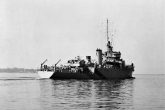
The H.M.S. REGULUS (J327) during her trial runs in Toronto, Canada. (Archive Dimitris Galon) -
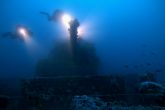
The 102 mm naval gun (QF 4 inch MkV) on the bow of the shipwreck. (Archive Antonis Grafas) -
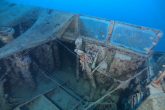
The outer part of the bridge where a part of the trawl net with which it is covered is visible. (Archive Antonis Grafas) -
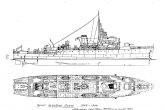
Design drawings of the ALGERINE class Minesweeper to which the H.M.S. REGULUS belonged to. (Archive Dimitris Galon) -
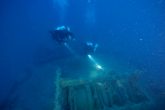
The towing mechanism used for minesweeping in the stern area. (Archive Antonis Grafas) -
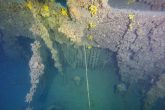
Part of the stern. (Archive Antonis Grafas) -

The H.M.S. PROVIDENCE (J325), sister ship of H.M.S. REGULUS (J327) in the summer of 1944 on the day of her departure from Toronto, Canada, with a final destination in England. (Archive Dimitri Galon) -
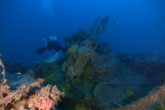
One of the twin antiaircraft Oerlikon guns of 20 mm (Archive Antonis Grafas) -
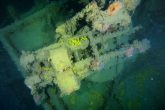
Twin Oerlikon abtiaicraft guns with its distinctive magazines. (Archive Antonis Grafas) -
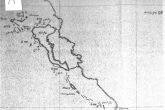
Map of the German minefields in the Ionian Sea. In the southeastern part of Corfu, the Mortus minefield is distinct. (Archive Dimitris Galon) -
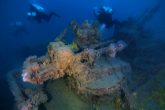
20mm Oerlikon antiaircraft gun (Archive Antonis Grafas) -

Remains from the ship's funnel (Archive Antonis Grafas) -
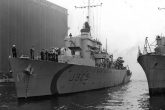
A typical sample of an ALGERINE class, the H.M.S. PROVIDENCE (J325), sister ship of the H.M.S. REGULUS (J327) in Toronto. (Archive Dimitris Galon) -

The team that carried out the dive at H.M.S. REGULUS (J327) in January 2019. From the the left Andreas Birbilis, Antonis Grafas, Alexandros Marketos, Yannis Liardakis, Giorgos Kolikis, Panagiotis Vletsas. (Archive Antonis Grafas) -

Video from the H.M.S. REGULUS ( J 327 ) Minesweeper
The British Mine layer H.M.S. REGULUS (J327)
Immediately following the departure of the German army from Athens in September 1944, ships of the Greek Royal Navy, assisted by naval mine sweepers of the British Royal Navy, 5th MSF [1] on October 15, 1944, within the remit of “Operation Manna”, opened a channel for allied fleet ships that carried the Greek Middle East government from Poros to Piraeus. After the withdrawal of the German occupation army from Thessaloniki on October 30, 1944, and the final liberation of mainland Greece [2], the 5th Minesweeper Flotilla broadened its mine sweeping operations with the aim of restoring navigation on the Greek seas. Since January 1945, this effort had been attained by six ships and the 8th Minesweeper Flotilla (MSF), which undertook the clearing of the German mine barrier in the marine area of the Ionian Sea. On January 12, 1945, and while the 8th Minesweeper Flotilla group was operating, the H.M.S. REGULUS was operating in the German Mine reservoir at 39 ° 24 B / 20 ° 10 A coordinates, struck its stern on a mine whose explosion caused considerable damage and an opening from which a large amount of water
flowed into the interior of the ship, as a result leading to its sinking. The wreck of H.M.S. REGULUS (J327) was first identified and surveyed by Vassilis Mentogiannis and his team in August 2002, following information from a local fisherman. 74 years after the ship’s sinking on January 5, 2019, Antonis Grafas and his team, supported by Alexander Marketou’s deepbluedivers diving center, also dived the wreck for the purpose of further research and documentation.
Construction and technical characteristics
H.M.S. REGULUS was an “ALGERINE” class minesweeper [3], which was ordered in July 1942 for the Royal Canadian Navy at Redfern Construction Co. (Toronto Dry Dock) in Toronto, Canada. Its construction began on 15 April 1943 with a construction number 49 and was completed on the 30th of May 1944. The ship was to be named H.M.C.S. LONGBRANCH but before completion at the shipyard she joined the 8th Navy Flotilla of the British Royal Navy taking the name H.M.S. REGULUS and tactical code J327. It was the fourth Royal Navy vessel that received this name and had a gold lion on a blue background holding a silver star as its coat of arms. At the base of the coat of arms it was written ‘In primus pro patria’. [5]
The overall characteristics of the ship were:
Name: His Majesty’s Ship REGULUS
Identifying Code: J327
Type: ALGERINE minesweeper
Nationality: British
Corps: Royal Navy
Displacement: 1010 tonnes (full load 1305 tonnes)
Length: 68.6 meters
Width: 10.8 meters
Draft: 3.4 meters
Propulsion: 2 vertical reciprocating thrusts
Propellers: 2
Indicative speed: 16 knots
Autonomy: 5000 nautical miles at a speed of 10 knots
Arming: A 102mm (QF 4 inch MkV) naval gun, four 20mm Oerlikon antiaircraft twins, 92 bomb displacement capability, and a Oropesa mine sweaping mechanism.
Indicative crew: 118 people (8 officers and 110 crew)
Combat Operation
In June 1944, following the delivery of the ship to the Royal Navy and the completion of its trial runs, H.M.S. REGULUS prepared for the Atlantic crossing. She departed from Toronto in July with her sister ship the H.M.S. PROVIDENCE (J325) having a final destination at the British isles. One month later, she completed the necessary naval tests in England and left with H.M.S. PROVIDENCE (J325) for Gibraltar where she participated in mining operations. In October of the same year she departed with H.M.S. PROVIDENCE (J325), H.M.S. COQUETTE (J350), and H.M.S. ROWENA (J384) for Malta for the purpose of mine sweeping and the opening of the sea area around the Gozo and Malta islands. On December 44, she was sent with other ships to the 8th Minesweeping Flotilla in Taranto, Italy, for the purpose of carrying out mine sweeping in the Adriatic. On January 4, 1945, H.M.S. REGULUS departed with H.M.S. THISBE (J302), H.M.S. ROWENA (J384), H.M.S. MARYROSE (J360) and H.M.S. FLUELLEN (T157) for Corfu where she participated in the clearing of the Ionian Sea area from the German, Italian and Greek minefields of World War II. From the 5th to the 7th January of 1945, the aforementioned 8th MSF ships managed to neutralize 30 mines and clear the port of Corfu.
The sinking
On January the 12th, 1945, H.M.S. REGULUS was among other ships of the 8th MSF in the southeastern part of Corfu, in the area of the German minefield [8], where she struck a mine. By midday, 20 mines had been eliminated when H.M.S. REGULUS hit a mine, causing significant damage to the stern and created a crack in the hull resulting in a massive influx of water, which soon led to the partially sinking of the aft section. At the same time, the explosion caused damage to the propeller and its axis, rendering the ship unmanageable and unable to maneuver. H.M.S. REGULUS was towed in order to rescue her, but as the water inflow continued the order was given to abandon her, she sank after 45 minutes after the blast. There was only one loss from the crew but many injured.
The wreck
The wreck of the H.M.S. REGULUS is standing on a sandy bottom with a maximum depth of 63 and a minimum of 50 meters. The imaginary stern-to-bow axis is 270 degrees. Although its stern is damaged, the wreck remains in one piece without any cracks in the overall length of the hull. The outer part of the bridge, the bridge itself, and part of the main superstructure, are covered by a large trawl net. The 102mm bow cannon is clearly visible and does not carry any fishing gear. In the mid-ship and the stern area, the two twin 20mm Oerlikon anti-aircraft guns are clearly distinguishable with their magazines in place. In the same area, there is a distinct towing winch and the mine cutter, with the rope being wrapped in its place. The two anchors of the bow are intact in and many details of the construction are visible, although heavily covered with benthic organisms. The propellers of the ship are not so visible as they are apparently buried on the sandy bottom H.M.S. REGULUS. Although not a direct war loss, due to the fact that its sinking took place when there was no hostile army in Greece, it was rightly included in the war losses as her sinking resulted from a warfare action that took place in the form of clearing and opening enemy minefields in the Greek Marine area. One must appreciate and not ignore the fact that H.M.S. REGULUS belongs to the historical wrecks of the Greek seas, being at the same time one of the most important examples of British shipbuilding that is immersed in the Greek seas.
DG
References, Further Notes, Clarifications
[1] 5th Minesweeping Flotilla
[2] Apart from Milos, part of the Dodecanese, and part of northern Crete, which were liberated in the spring of 1945.
[3] The ALGERINE class emerged as a result of the need for the British Royal Navy to build strong naval mine sweepers, which would attempt multiple roles such as escort to convoys, patrol and, of course, naval mine clearing. The decision to build this class was taken in September 1940. By the end of the war, a total of 110 ships of this class were built, of which 50 were built in Belfast, Ireland and Scotland, while the remaining 60 were built in Canada.
[4] The other ships of the same name were the REGULUS of 1785, which was disbanded in 1816, the REGULUS of 1804, which originated from the French Navy as a war loot, and the submarine REGULUS of 1930, which was lost in December of 1940 in the Adriatic.
[5] “Over the World”
[6] Sivota of the prefecture of Thesprotia
Sources
Colledge, J.J. / Warlow, Ben: Ships of the Royal Navy: The Complete Record of All Fighting Ships of the Royal Navy from the 15th Century to the Present, Casemate 2009
The Algerines Association (http://www.minesweepers.org.uk/)
Williams, Jack: The Algerines – Fleet Minesweepers of the Royal Navy, 1942-1961, J.F. Williams 1995
Terniotis, Giannis: Mine laying and sweeping in the Greek Seas between 1940 to 1950, Naval History Magazine, Issue 2, April-June 2005

